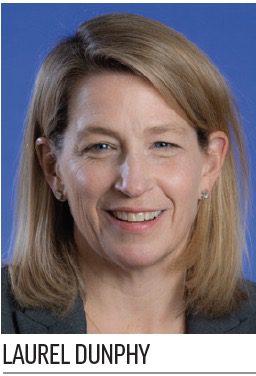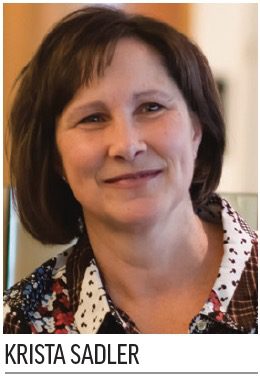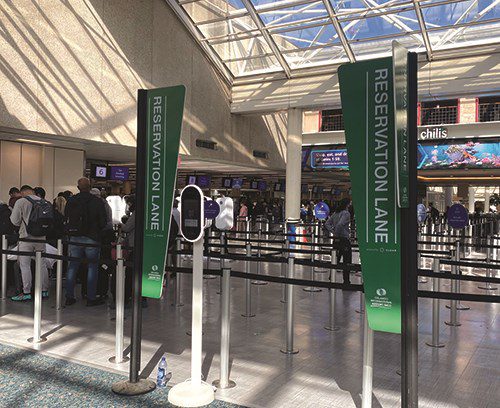Wait times at TSA checkpoints have long been a wildcard for travelers, and the COVID pandemic has only exacerbated the unpredictability. In addition, it has heaped on the additional need to maintain proper social distancing while passengers wait in line.
Wait times at TSA checkpoints have long been a wildcard for travelers, and the COVID pandemic has only exacerbated the unpredictability. In addition, it has heaped on the additional need to maintain proper social distancing while passengers wait in line.
 But the industry is on it. With an eye toward improving the customer experience, many airports took advantage of the unexpected downtime last year while passenger traffic slumped to make improvements. Two airports in particular—Seattle-Tacoma International Airport (SEA) and Orlando International Airport (MCO)—zeroed in on improving the predictability of checkpoint wait times for passengers.
But the industry is on it. With an eye toward improving the customer experience, many airports took advantage of the unexpected downtime last year while passenger traffic slumped to make improvements. Two airports in particular—Seattle-Tacoma International Airport (SEA) and Orlando International Airport (MCO)—zeroed in on improving the predictability of checkpoint wait times for passengers.
The two airports ended up with similar systems, but took very different routes to get there. By coincidence, the “happiest place on Earth” influenced both strategies.
|
Project: Online Reservations for Checkpoint Lines Objectives: Improving passenger satisfaction; managing security wait times
Location: Cost to Travelers: $0 Cost to Airport: Undisclosed System: Spot Saver by Pangiam, powered by WhyLine & Copenhagen Optimization Pilot Launch: May 2021 Passenger Use: Nearly 267,000 (as of Dec. 2021) Location: Orlando Int’l Airport System: Reservation Lane powered by CLEAR Cost to Travelers: $0 Cost to Airport: $0 (provided by CLEAR in exchange for opportunity to market its paid services to passengers) Launched: Oct. 2021 Passenger Use: 200,000 (as of Dec. 2021) |
The team at SEA blazed the trail and got its pilot up and running in May 2021. It chose technology firm Pangiam to build SEA Spot Saver, which allows passengers to claim specific queue times by making online reservations within 15-minute windows. At MCO, CLEAR approached airport management to provide Reservation Lane powered by CLEAR, which works in a similar manner. Its program launched in October 2021. In both cases, the service is free for passengers, and the airports have a new way to move passengers through security checkpoints in a more predictable manner.
Bake-Off in Seattle
When Lance Lyttle accepted his current position as managing director, Aviation Division, at SEA, lines at security checkpoints sometimes backed up into the airport garage, creating wait times of an hour or more. So Lyttle asked his team to come up with suggestions to mitigate the bottlenecks.
In the meantime, SEA employed a manual method Lyttle saw Customs and Border Protection use when he was traveling frequently from Toronto to the U.S. Staff would simply find travelers on flights leaving imminently and direct them to the front of the lines. At the time, technology for virtual queuing did not exist.
As the pandemic raged on, SEA pushed to come up with another solution. During a virtual travel conference that included hotels, airlines and airports, Lyttle was inspired by the way Disney uses times queues and implements technology to keep customers flowing smoothly through its theme parks. Millions of guests wait in lines at Disney properties every year. Could similar queuing methods work for airports, too? The team at SEA thought so.
“Lance had been thinking about ways to help expedite security checkpoint lines for a long time,” says Dave Wilson, director of Airport Innovations at SEA. “Once the pandemic hit, we learned about Disney’s efforts to address the same problem we had: physical distancing. At peak times, trying to keep people 6 feet apart could create a really long line.”
Lyttle compares the challenge to building a church that can handle a large influx of parishioners on Easter Sunday but still operate efficiently for far fewer people the rest of the year.
“The problem we’ve had is that people are coming all at the same time, as when a cruise ship is leaving the port,” he explains. “We don’t need as much physical space if we’re spreading out the passenger arrival times. Now we can get the same number of people across time, which will go a long way in terms of utilizing space effectively.”
SEA decided to look for a virtual queuing system in May 2020—just as Airports Council International-North American (ACI-NA) created a working group on that very topic. While participating in the group, Wilson and his team discovered many systems for restaurants and shopping malls, but none designed for airports.
 “The vendors said, ‘Oh, you can just hit the ‘next’ button to advance the next person in line,’” recalls Wilson. “Well, if you process 50,000 people per day, that’s carpal tunnel for a bunch of staff. There really wasn’t anything readily available for us.”
“The vendors said, ‘Oh, you can just hit the ‘next’ button to advance the next person in line,’” recalls Wilson. “Well, if you process 50,000 people per day, that’s carpal tunnel for a bunch of staff. There really wasn’t anything readily available for us.”
What SEA learned from the ACI-NA working group, however, helped inform the airport’s subsequent Request for Information to the industry. The procurement office at SEA also took a page from a pilot program at Boston Logan International Airport (BOS), which sought pilot project proposals from several different providers. But while BOS was tapping technology startups for a solution, SEA oriented its search toward more established companies.
Two vendors that answered SEA’s call, Pangiam and Virtual Hold Technology Solutions, were chosen to participate in a head-to-head pilot program at SEA—a bake-off for technology providers. It’s common for the Port of Seattle to collaborate with airlines for test programs, and SEA Airport Operations Director Laurel Dunphy brought in two for the virtual queuing program. Pangiam was paired with Alaska Airlines, which currently accounts for about half of SEA’s total flights, and Virtual Hold Technology was paired with Delta Air Lines, which provides about 24%.
 “The airlines could look at it from an operational perspective,” says Dunphy. “They want predictability, and this provides that to their customers, and ours. We haven’t even really started to scratch the surface on what can be done, but the feedback was fantastic. I haven’t seen anything score so well at an airport before this.”
“The airlines could look at it from an operational perspective,” says Dunphy. “They want predictability, and this provides that to their customers, and ours. We haven’t even really started to scratch the surface on what can be done, but the feedback was fantastic. I haven’t seen anything score so well at an airport before this.”
Krista Sadler, director of ICT Tech Delivery at SEA, reports that both vendors brought strong ideas to the table and were easy to work with. “We knew there wasn’t an established product in the market for airports, and we were open to anyone who had a good solution, and one that could grow with us,” Sadler says. “Both vendors did a good job innovating during the process of the pilot to fit the scenarios on the ground.”
 Ultimately, Pangiam emerged as the better fit for SEA—partially because it is so data-focused, says Sadler. “The company brought an analytic mindset to the process, and many of the proposals and ideas they brought forward were based on that data,” she explains. “One thing the IT team didn’t know at the kickoff of the launch is how important online reservations would be. Pangiam’s initial solution came with a reservation feature, which allowed the company to build on top of that.”
Ultimately, Pangiam emerged as the better fit for SEA—partially because it is so data-focused, says Sadler. “The company brought an analytic mindset to the process, and many of the proposals and ideas they brought forward were based on that data,” she explains. “One thing the IT team didn’t know at the kickoff of the launch is how important online reservations would be. Pangiam’s initial solution came with a reservation feature, which allowed the company to build on top of that.”
In addition, Pangiam’s software is web-based, which enables add-ons like passenger surveys.
CLEAR Skies in Florida
At MCO, management chose Reservation Lane powered by CLEAR, which also offers online reservations for checkpoints to its customers. MCO’s virtual queuing pilot kicked off on Oct. 21, 2021, and will be evaluated after one year.
With more than 34 million passengers flying in and out of MCO per year and a terminal at capacity, the Greater Orlando Airport Authority found 2021 to be an opportune time to evaluate many of its processes, including checkpoint line management. The airport’s proximity to the Disney complex in Orlando afforded personnel a chance to visit its quintessential theme parks to see how wait times are managed. In turn, MCO invited Disney staff to see how queuing works at the airport.
During this research, CLEAR approached the airport team with a proposal: Let us offer a free online reservation service to passengers in exchange for the opportunity to market our paid membership to them. Typically, a CLEAR membership costs travelers up to $179 per year; members use face and eye biometrics rather than traditional paper documents to expedite their security screening. By running the pilot program at MCO, CLEAR collects email addresses, which is a goldmine of customer data. Using the Reservation Lane powered by CLEAR is complimentary, but travelers are still at the mercy and whim of traffic patterns; so they may be interested in upgrading to paid membership with CLEAR once they get a feel for the process. If passengers choose to provide information for Reservation Lane privileges, CLEAR gains the opportunity to try to upsell them.
From the airport’s perspective, only two elements were required to add the online reservation option: a power source to run the scanning device at the beginning of the queue and a strong Wi-Fi connection. Brian Engle, director of Customer Experience for the Greater Orlando Aviation Authority, notes that MCO didn’t have to upgrade its Wi-Fi network. The IT staff simply had to ensure a direct line that was unhampered by use from passengers or other vendors.
Managing Leisure Passengers
United Airlines was quick to join the Reservation Lane program at the very beginning of the pilot. Now, MCO is looking to include more airlines. Engle notes that more than 90% percent of travelers at MCO pass through the two security checkpoints, and lines can get lengthy.
Because 80% of MCO’s shopping and dining is landside, capturing the attention of travelers before they get to the security line is key. A strong concessions lineup is part of the whole “Orlando Experience” the airport hopes to deliver, and reducing stress for travelers on leisure trips is an important aspect. Time really is money when it comes to making passengers confident enough about checkpoint wait times to shop in the meantime.
“Reservation Lane powered by CLEAR is for the traveler who doesn’t just like to plan travel, but likes to plan ahead,” says Ken Lisaius, vice president of Public Affairs and Communications for CLEAR. “They can now use the time they saved to look around airport shops or spend it making a stop for lunch at that restaurant they didn’t think they would have time to try.”
The busiest days of the week at MCO are Saturdays and Sundays, when leisure travelers are arriving for vacation or returning home after spending a week in the Orlando area. The pilot program is revealing that on those peak days, travelers aren’t finding out about the reservation system until after they arrive at the airport. Signage directs them to scan the QR code, and if slots are available, passengers can book them. However, that means those days are slower on the uptake than, for instance, Tuesdays or Wednesdays, which are more common days for business travel.
 “More business travelers are discovering the reservation system, and week after week, we’re seeing the numbers rise,” Engle reports. “Pre-bookings are inching up, and that’s the whole intent of the program.”
“More business travelers are discovering the reservation system, and week after week, we’re seeing the numbers rise,” Engle reports. “Pre-bookings are inching up, and that’s the whole intent of the program.”
About 200,000 passengers had used the new reservation option at MCO by December 2021.
Here to Stay?
Engle reports that customers at MCO are reacting positively to the virtual queuing pilot. The challenge the airport is working through now is limited hours: The option is only available from 5 a.m. to 11 a.m., local time. As word about the program spreads, more people—especially international travelers—are asking for afternoon reservations.
That issue aside, Engle says the edges are smoothing out, and even the no-show number is improving. In December, it was holding steady at about 30%, which was a 10% to 15% improvement over no-shows during the launch.
“The idea was long overdue, and it took time to get the system established and piloted,” he reasons. “There is room for further growth; it’s just a matter of getting the word out. The TSA is very happy with the program so far, and we’d like to see it expand and add more lanes in
the future.”

Management at SEA is similarly optimistic. In fact, the airport plans to include the virtual queuing system provided by Pangiam in its new airport app, which is scheduled to roll out in mid-2022. Since July, nearly 267,000 passengers have used Spot Saver, and the numbers continue to grow.
Lyttle reports that the new online reservation system addresses the airport’s vision of a predictable journey, with less stress for passengers. It also provides a wider range of passengers with more travel options, he adds.
“One of the complaints we were receiving was that travel was for the elite, and if you’re not part of a frequent flyer program or flying business class, you’re not getting the same treatment,” Lyttle explains. “This levels that playing field. You can reserve a space in line and do it for free, which definitely addresses the equity component.”

There is concern about the concept from concessionaires. Some fear that virtual queuing services will minimize or even eliminate dwell time…that passengers with reservations for clearing security checkpoints will arrive at the airport just in time to get to their gates for departure. However, SEA still instructs passengers to arrive two hours before their flight time to build in a buffer for the relaxed, stress-free shopping and dining time that’s valuable to all airports.
“We’re hoping this is extremely successful and that it makes the screening process far more efficient overall,” says Lyttle.


 facts&figures
facts&figures

